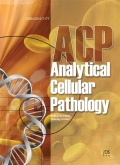Authors: Gomes, Ana L. | Reis-Filho, Jorge S. | Lopes, José M. | Martinho, Olga | Lambros, Maryou B.K. | Martins, Albino | Schmitt, Fernando | Pardal, Fernando | Reis, Rui M.
Article Type:
Research Article
Abstract:
Gliomas are the most common and devastating primary brain tumours. Despite therapeutic advances, the majority of gliomas do not respond either to chemo or radiotherapy. KIT, a class III receptor tyrosine kinase (RTK), is frequently involved in tumourigenic processes. Currently, KIT constitutes an attractive therapeutic target. In the present study we assessed the frequency of KIT overexpression in gliomas and investigated the genetic mechanisms underlying KIT overexpression. KIT (CD117) immunohistochemistry was performed in a series of 179 gliomas of various grades. KIT activating gene mutations (exons 9, 11, 13 and 17) and gene amplification analysis, as defined by chromogenic in
…situ hybridization (CISH) and quantitative real-time PCR (qRT-PCR) were performed in CD117 positive cases. Tumour cell immunopositivity was detected in 15.6% (28/179) of cases, namely in 25% (1/4) of pilocytic astrocytomas, 25% (5/20) of diffuse astrocytomas, 20% (1/5) of anaplastic astrocytomas, 19.5% (15/77) of glioblastomas and one third (3/9) of anaplastic oligoastrocytomas. Only 5.7% (2/35) of anaplastic oligodendrogliomas showed CD117 immunoreactivity. No association was found between tumour CD117 overexpression and patient survival. In addition, we also observed CD117 overexpression in endothelial cells, which varied from 0–22.2% of cases, being more frequent in high-grade lesions. No KIT activating mutations were identified. Interestingly, CISH and/or qRT-PCR analysis revealed the presence of KIT gene amplification in 6 glioblastomas and 2 anaplastic oligoastrocytomas, corresponding to 33% (8/24) of CD117 positive cases. In conclusion, our results demonstrate that KIT gene amplification rather than gene mutation is a common genetic mechanism underlying KIT expression in subset of malignant gliomas. Further studies are warranted to determine whether glioma patients exhibiting KIT overexpression and KIT gene amplification may benefit from therapy with anti-KIT RTK inhibitors.
Show more
Keywords: Gliomas, glioblastomas, anaplastic oligoastrocytomas, KIT, mutations, amplification, CISH, quantitative real-time PCR
Citation: Analytical Cellular Pathology,
vol. 29, no. 5, pp. 399-408, 2007
Price: EUR 27.50





